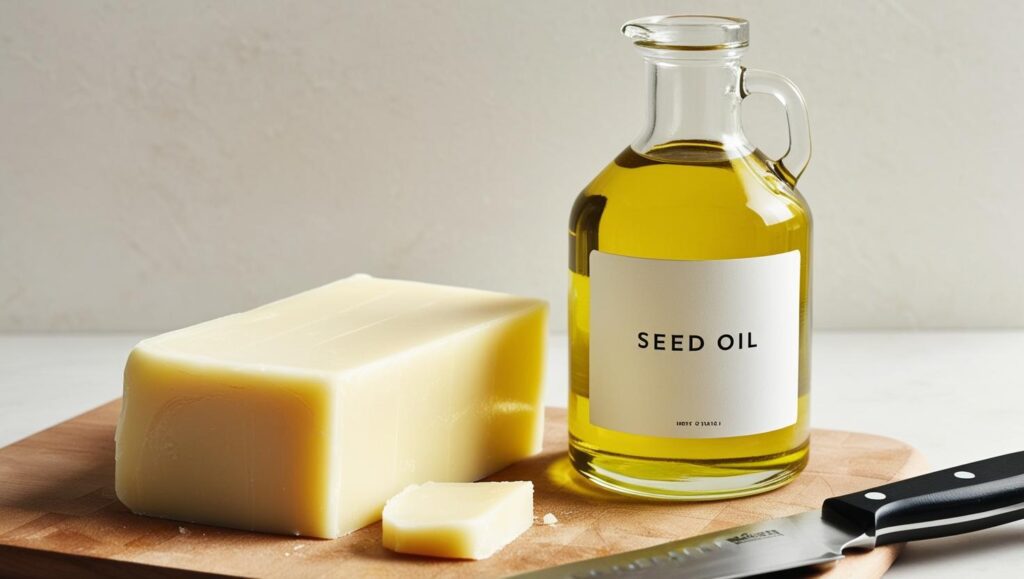In recent years, the debate over dietary fats has intensified, with people questioning whether traditional animal fats like tallow or modern seed oils are the better choice for overall health. While both have their proponents, a closer look at scientific research suggests that tallow may offer superior benefits when compared to seed oils. Let’s break down the facts.

Understanding Tallow and Seed Oils
What is Tallow? Tallow is rendered fat from beef or mutton, traditionally used for cooking and skincare. It is rich in saturated and monounsaturated fats, along with fat-soluble vitamins such as A, D, E, and K. Tallow was widely used in cooking before the rise of industrial seed oils in the 20th century.
What Are Seed Oils? Seed oils, including canola, soybean, sunflower, corn, and safflower oil, are extracted from seeds using mechanical pressing or chemical solvents. These oils are high in polyunsaturated fatty acids (PUFAs), particularly omega-6 fatty acids. Due to their affordability and stability, seed oils have become a staple in modern processed foods.
Nutrient Density: Which Fat is More Nutritious?
One of the key differences between tallow and seed oils is their nutrient profiles.
- Tallow is packed with fat-soluble vitamins that play essential roles in immune function, skin health, and bone development. It also contains stearic acid, a type of saturated fat that has been shown to support healthy mitochondrial function and metabolic health.
- Seed oils, on the other hand, lack significant amounts of fat-soluble vitamins. While they contain some vitamin E, their overall nutrient density is far lower than tallow.
Fatty Acid Composition and Health Impact
Saturated vs. Unsaturated Fats
Tallow consists mainly of saturated fats (50-55%) and monounsaturated fats (40-45%), with only a small percentage of polyunsaturated fats. This composition makes it highly stable and resistant to oxidation when heated.
Seed oils, however, are predominantly polyunsaturated fats (PUFAs), particularly omega-6 fatty acids. While PUFAs are essential in small amounts, excessive consumption has been linked to increased inflammation, oxidative stress, and metabolic disorders.
Omega-6 to Omega-3 Ratio
A major concern with seed oils is their high omega-6 to omega-3 ratio. Historically, humans consumed a near 1:1 ratio of these fats, but modern diets now average closer to 20:1 in favor of omega-6s. This imbalance has been associated with chronic inflammation, which can contribute to conditions like heart disease, obesity, and autoimmune disorders.
Tallow contains a much more balanced fatty acid profile with naturally occurring omega-3s and very little omega-6, making it a better option for maintaining a healthy inflammatory response.
Cooking Stability: Which Fat Performs Better?
Cooking oils must be stable at high temperatures to prevent oxidation and the formation of harmful compounds like trans fats and aldehydes.
- Tallow is highly stable due to its high saturated fat content, making it an excellent choice for frying, roasting, and baking.
- Seed oils, by contrast, are unstable at high temperatures. PUFAs are prone to oxidation, leading to the production of harmful free radicals that can damage cells and contribute to aging and disease. Studies show that repeatedly heating seed oils can produce toxic compounds linked to heart disease, cancer, and neurodegenerative conditions.
Impact on Heart Health
For years, saturated fats were demonized as a cause of heart disease, but recent research has challenged this narrative.
- A meta-analysis of over 70 studies found no significant link between saturated fat consumption and heart disease.
- Emerging evidence suggests that natural saturated fats, like those found in tallow, may improve lipid profiles and support cardiovascular health when consumed as part of a whole-foods diet.
Conversely, excessive intake of seed oils has been linked to oxidized LDL cholesterol, endothelial dysfunction, and arterial inflammation, all of which are key contributors to cardiovascular disease.
Inflammation and Disease Risk
Inflammation is a root cause of many chronic diseases, and diet plays a crucial role in either exacerbating or reducing it.
- Tallow is inherently anti-inflammatory due to its high concentration of saturated and monounsaturated fats, which are less likely to trigger oxidative stress.
- Seed oils promote inflammation due to their high omega-6 content. Studies suggest that excessive omega-6 intake contributes to conditions like arthritis, obesity, and even mental health disorders.
Conclusion: Which Fat Packs the Best Punch?
Based on scientific evidence, tallow emerges as the superior fat for both cooking and overall health. Its high nutrient density, heat stability, and balanced fatty acid profile make it an excellent choice for those looking to optimize their diet. While seed oils may be convenient and inexpensive, their high PUFA content and inflammatory properties raise serious concerns.
If you’re looking to make the switch to healthier fats, choosing tallow over seed oils could be a game-changer for your health. Opt for grass-fed, high-quality tallow whenever possible to maximize its benefits.
What are your thoughts on the great fat debate? Let us know in the comments! 👇🥩
Find us on Facebook or Instagram and join our growing community. You can also find our range of whole foods and supportive supplements here. Let’s embark on a journey towards better health together!
References:
- DiNicolantonio, J. J., O’Keefe, J. H., & Wilson, W. (2018). “Saturated fat is not the major issue.” Progress in Cardiovascular Diseases, 61(5-6), 419-424.
- Ramsden, C. E., Zamora, D., Majchrzak-Hong, S., et al. (2016). “Re-evaluation of the traditional diet-heart hypothesis: Analysis of recovered data from the Minnesota Coronary Experiment.” BMJ, 353, i1246.
- Blasbalg, T. L., Hibbeln, J. R., Ramsden, C. E., et al. (2011). “Changes in consumption of omega-3 and omega-6 fatty acids in the United States during the 20th century.” American Journal of Clinical Nutrition, 93(5), 950-962.
- Ghosh, S., & Kuhn, D. E. (2020). “The role of dietary fats in chronic disease.” Nutrients, 12(10), 2993.
This article was whipped up with a little help from our AI sidekick, making it faster and more fun to bring you all the tasty, nutritious goodness!
Disclaimer: This information is for general knowledge and informational purposes only and does not constitute medical advice. Consult a healthcare professional for personalised dietary guidance.

